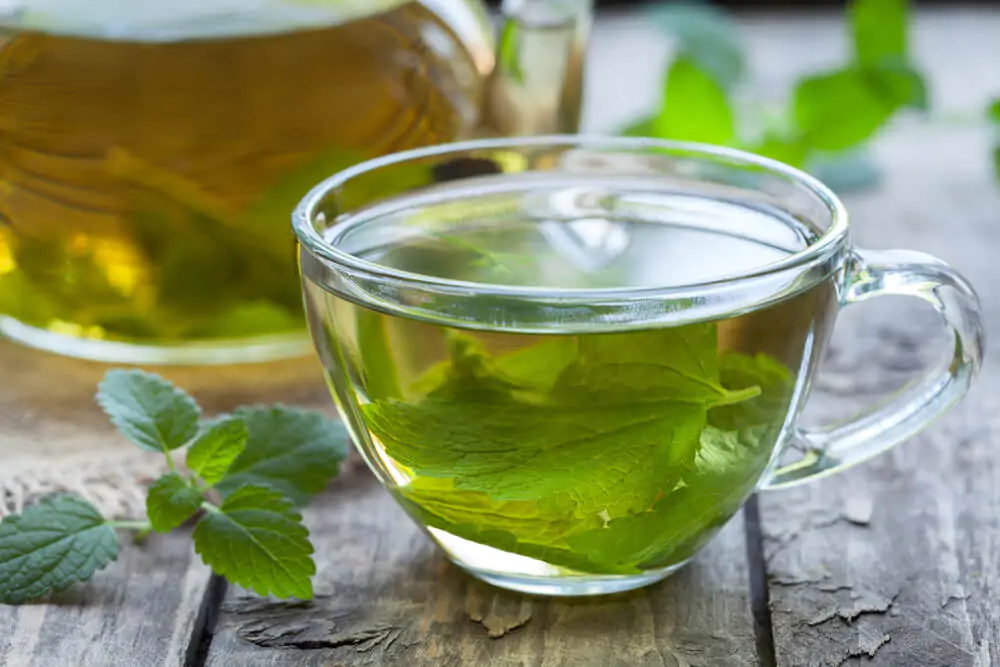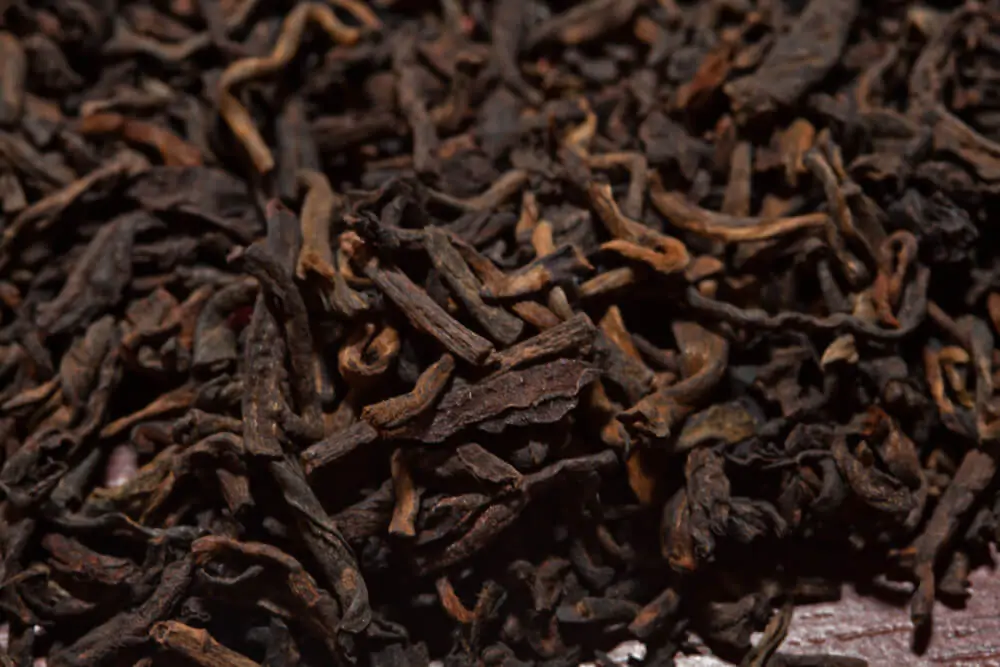While all teas go through the process of oxidation, only certain types of tea go through a fermentation process. So, is green tea fermented? Keep reading to find out.

With fermented tea-based drinks, such as kombucha, growing in popularity, you might also wonder if other teas, like green tea, can also be fermented. This is not the case.
Although the word “fermentation” is usually used to describe the processing of green tea, green tea is oxidized, not fermented. Fermentation is the process where bacteria and fungi break down organic material. This process does not occur when preparing and manufacturing green tea.
Oxidation occurs when tea leaves are exposed to air, which makes then drier and darker, which alters the tea’s taste, strength, and aroma. As mentioned earlier, what happens during the processing of green tea is oxidation — it takes place when oxygen reacts to the enzymes within the cell walls of the tea leaves.
Fermentation Vs. Oxidation In Tea
There two potential theories for the misconception between fermentation and oxidation in the world of tea:
- Tea was created long before there was a scientific reasoning for these practices.
- Tea originated in China. Most of the knowledge about tea in the Western world has been translated, running the risk of misconceptions being perpetuated.
When we talk about tea, remember the process used nowadays is quite the same as the process used a few thousand years ago. Without the aid of science, the oxidation and fermentation processes would have probably seemed very similar; thus, it makes sense that people would have used the terms synonymously. The terms were already part of the tea-making lexicon by the time we were able to distinguish between the two.
You’ll love our round-up of the best Japanese green tea brands.
How Is Green Tea Made?
Most teas come from the Camellia sinensis plant. The main difference is that the teas are processed differently — for example, the extent to which the tea leaves undergo oxidation. The oxidation process significantly alters the tea’s color, flavor, and strength.
- White tea is the least oxidized.
- Green tea is slightly oxidized, under 30%.
- Oolong tea is oxidized between 30 to 70%.
- Black tea is the most oxidized more than 70 to 80%.
Green tea is significantly less oxidized than black tea. This makes it a milder tea, known for it’s “grassy” notes.
7 Steps To Process Green Tea
Understanding the steps to process tea may also help you learn about why oxidation is crucial.
Here are the 7 steps in processing green tea leaves:
1. Growing
Tea plants typically grow in tropical and subtropical regions with warm weather and humid air. Tea plantations are commonly situated on foothills, hillsides, and mountains. A higher elevation means more humidity, which allows the plants to thrive.

2. Harvesting
There are different ways to harvest tea leaves, it can be picked by hand, or using machines. Although it’s not uncommon to see a combination of the two being utilized. Harvesting usually takes place two times a year.
Teas of higher quality and those with less oxidation tend to be picked by hand. Teas of lower quality and black tea can be harvested using a machine since it does not matter as if the tea leaves are torn or damaged during the harvesting process.
3. Wilting
After the tea leaves are picked, they are dried under the sun or left in an airy room for several hours to lose moisture.
- White teas usually go straight to “Fixing.”
- Green teas usually skip “Bruising” but are oxidized for a bit (but less than black teas).
4. Bruising (Optional)
Bruising is also known as leaf disturbance or leaf maceration. After wilting, the tea leaves are rolled, cut, and torn. Bruising can be done either by hand or with a machine.
By damaging the tea leaves, more cell walls will be exposed to air, which causes them to oxidize more quickly and thoroughly.
5. Oxidizing
Technically, the oxidation process begins right when the leaves are picked until they’re exposed to heat. This is probably the most important step in the process as it will significantly affect the flavor and the type of tea produced.
Some types of tea are more oxidized compared to others, which is what makes true teas so different from each other.
- Less oxidized tea leaves will have delicate, floral, grassy, and mellow flavor profiles.
- More oxidized tea leaves will have a fuller, malty, earthy flavor.
The oxidation process is like wilting — the leaves are dried in the sunlight or left in an airy room. They will get darker as they oxidize.
6. Fixing
When the desired oxidation level has been reached, the tea leaves are “fixed.” This process uses heat to deactivate the tea’s enzymes and end the oxidation process.
There are several ways to fix tea leaves, including:
- Roasting
- Steaming
- Baking
7. Drying
Once the oxidation process has ended, the tea leaves are dried out, typically in the sunlight, a final time. Drying preserves the flavor of the tea leaves and prepares them for sale.

You may also be interested in reading our guide on how is tea transported.
How Are Fermented Teas Made?
There are many types of fermented teas, but most of them are not very popular with Western tea drinkers.
- Hei Cha
- Pu’erh
- Kombucha
- Pickled Tea Leaves
These teas are not made the same.
Hei Cha and “Ripe” Pu-Erh Tea
Hei Cha and ripe Pu’erh tea are types of true fermented teas, also known as post-fermented teas. They both undergo the traditional processing of tea. They are oxidized and stored in piles. For several weeks, the tea leaves are covered underneath a warm, wet, cloth to allow the bacteria and fungi to grow, which effectively ferments the tea.
Kombucha
Kombucha combines tea with yeast, bacteria, and sugar, allowing it to ferment. The resulting brew is somewhat carbonated and is slightly alcoholic. You may also be interested in reading our guide on how to make hard kombucha at home.
Pickled Tea Leaves
Pickled tea leaves are a popular snack in many countries, particularly in Asia.
Fermented Tea Health Benefits
Like other tea varieties made from the Camellia sinensis tea plant, Pu’erh tea contains high levels of antioxidants. It also has an energizing effect due to its caffeine content comparable to black tea and about half the caffeine in a regular cup of coffee.

Pu’erh tea is a type of fermented tea that offers many potential health benefits, including:
- Aids in digestion
- Boosts energy levels
- Improves brain performance
- Lower in tannins
- Rich in antioxidants
Although studies about the potential side effects of Pu’erh tea are still in progress, evidence shows that fermented teas have many health benefits.
FAQs About Fermented Tea
Is Black Tea Fermented?
Black tea is not fermented but oxidized. During the oxidation process, the tea leaves are exposed to air, which causes them to dry and darken, resulting in a stronger and more flavorful cup of tea. Unlike fermented teas, black teas are not aged.
You may also be interested in reading our guide on Pu’erh tea vs. black tea.
Is White Tea Fermented?
White tea is not fermented. It is the least processed tea from the camellia sinensis tea plant. Tea leaves are harvested by hand and then air dried in the sun — during this process, the tea leaves undergo a small amount of oxidation.
Is Fermented Tea Good For You?
Yes, fermented tea offers many health benefits! Teas such as Pu’erh tea can aid digestion, improve brain performance, and give you energy throughout the day. It is also smoother and has fewer tannins than other tea types.
You may also be interested in reading our guide on fermented tea.
